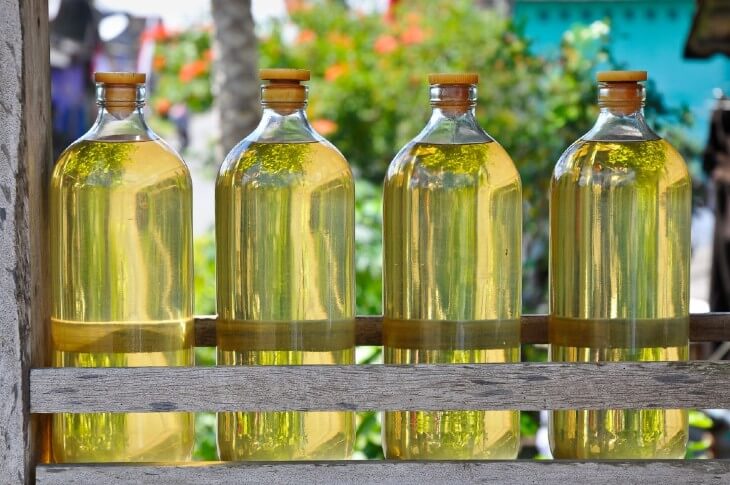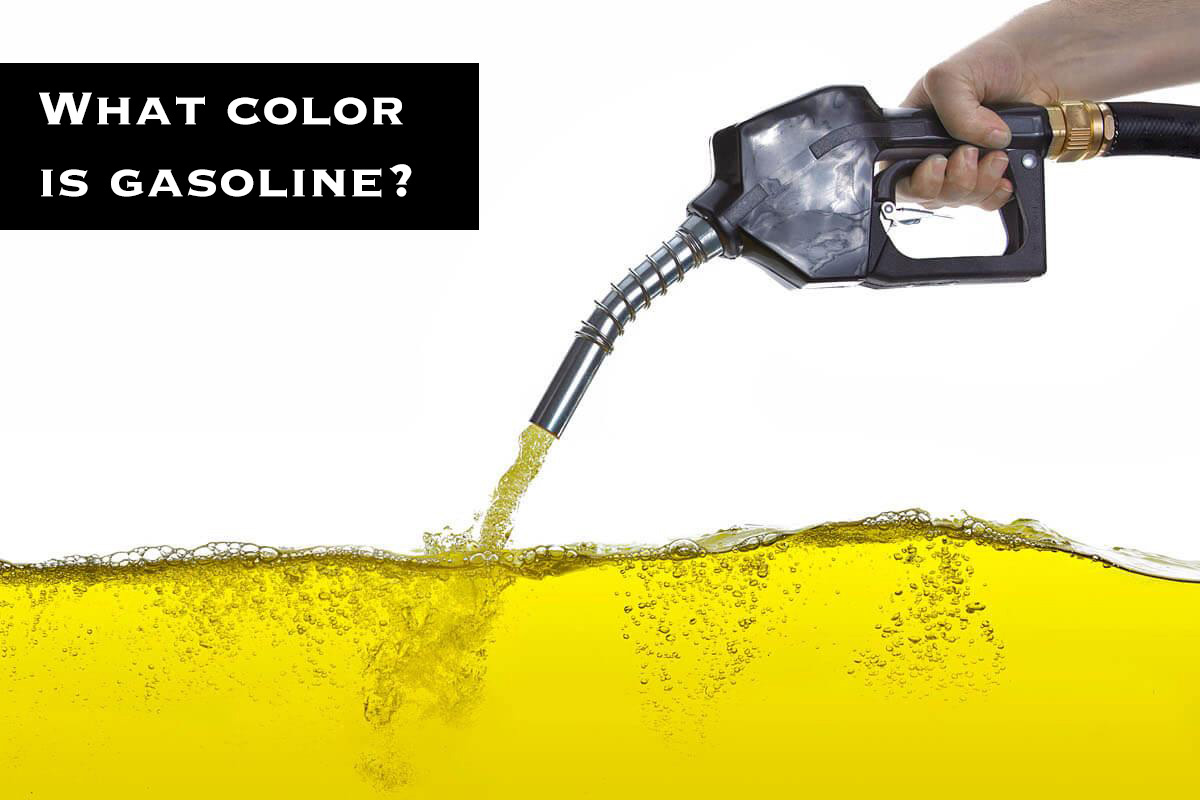What color is gasoline?
That's a good question and one that is pretty much impossible to answer. The color of gasoline (more specifically petrol), like all other liquids, changes with the light source it reflects. This means that if you were to take a sample of gasoline outside on a sunny day, it would look different than if you were to take another sample indoors under fluorescent lights.
Under direct sunlight gasoline generally tends to look more on the clear side, with a slight yellow/gold tint. Under fluorescent light, however, gasoline generally looks more of an amber color. Although this is not always the case—under an office florescent light you might even see some gasoline that still appears slightly yellow-ish under florescent light.
Regardless of the color change under different lighting, gasoline is combustible and quite toxic, so you might want to keep it away from your skin no matter what color it appears to be in.
Though many chemicals make up gasoline (over 600 in fact), most people refer to it as either being regular or premium grade. The difference between regular and premium gas is determined by octane level—the higher the octane level, the more expensive the gas will generally be per gallon. This difference in octane level determines whether or not the individual molecule of gasoline can explode when triggered by a spark during the combustion process. Regular-grade gasoline's lower octane level means that its molecules are unable to withstand high.
What is Gasoline?

Gasoline is the main source of fuel for many machines these days. It can be used in cars, trucks, chainsaws, and even generators. However, it has to be mentioned that not all gasoline types are suitable for each type of machine.
Gasoline is a flammable, colorless, and odorless liquid. It's also known as petrol (British English), and it's typically found in fuel tanks of cars and other motor vehicles. Gasoline has an octane rating that measures the gasoline's resistance to detonation or 'knocking' inside an internal combustion engine. The higher the gasoline's octane rating, the more compression it can stand before igniting, ensuring your vehicle gets the most power from its engine.
Gasoline is refined from crude oil, but not all crude oil is suitable for producing gasoline. When buying gasoline from a pump at your local gas station, you have no way of knowing how much refining was done to turn crude into usable fuel or what types of chemicals were added to raise its octane or make it smell nice. Despite a lack of knowledge about a particular gasoline's history, you can tell a lot about it by its color.
Why Different Gasoline Grades Have Different Colors?
Gasoline has no set color but varies depending on what chemicals were used in the refining process and where the original crude oil came from. Below are some common colors for gasoline:
- Blue - Indicates highly refined gasoline with low sulfur content.
- Green - Use to be common for gas stations before environmental concerns rose over the dumping of used motor oil into landfills. Now quite rare.
- Clear/Watery - As gasoline ages, its compounds break down and become more watery due to condensation within storage tanks and/or the addition of water during the refining process.
- Red - This color may indicate that gasoline has been mixed with alcohol or that it's known as 'ethanol free' and is gasoline adulterated with methanol. Methanol is toxic to car engines and can cause damage by rendering fuel injector nozzles unable to spray properly, among other problems. It can also severely corrode metal parts in your engine.
The only surefire way to tell if a gas station's gasoline contains ethanol or not is to ask an employee, but most people don't know the difference between ethanol and methanol in the first place. There are ways for consumers in regions where this practice is common (e.g., USA) to distinguish between ethanol and methanol, such as by looking at the color of a fuel filter to see if it's corroded. However you're unlikely to carry spare filters to test with, and these tests can also be misleading as different types of gas station pumps may dispense gasoline containing ethanol but still have corroded fuel filters.
Given these issues, the only surefire way to tell what particular gasoline contains is... well... to take a sniff at its fumes. If it smells like alcohol or has a strong chemical odor, do yourself a favor and don't use it in your car.
Types of Gasoline

There are many different grades of gas and they vary in color. Generally, the lower the octane is, the darker it gets.
The most common forms of gasoline that you can find in your local gas station, such as:
- 87 octane unleaded, has a golden yellow color when it is in its liquid form. However, when this grade of gasoline is burned in an engine it will leave behind a brownish-gray exhaust with a coffee-like odor. The black smoke and pungent smell are caused by incomplete combustion and unburned fuel and oil causing deposits to build up inside your vehicle's engine over time. This type of fuel also lacks lubrication properties for the piston's rings and valves which will cause excessive wear on these moving engine parts.
- 89 octane rating is a type of fuel that has an auto-ignition temperature of 111.7 °C (235.4 °F) and is what most cars require as a minimum. The octane rating refers to the level of compression ignition that the fuel can handle, which will also determine how clean or rough it will run in your vehicle.
- Gasoline is also available in higher octane or premium grades such as 91 which have a more expensive price due to their better burning properties, lack of pollutants created from combustion, and clean exhaust fumes. These types of fuel are usually dyed a blue color so you can distinguish them from the 87 octane fuel. Blue grade gas is recommended by car manufacturers for newer cars because they have direct injection engines that require higher quality gasoline to maintain efficiency.
What is the Difference Between Gasoline and Oil?
Both gasoline and oil are combustible liquids. The main difference between them is their source of origin. While oil is a naturally occurring factor, gasoline has to be refined before it can be used in machines or vehicles. The most commonly used types of gasoline are regular and premium-grade. However, there are other types available on the market for different purposes. For example, racing-grade fuel contains higher octane levels than regular-grade gasoline which makes it better suited for high-performance engines that require more power output.
However, one should not confuse racing-grade fuel with aviation/avgas grades of fuels since the latter type requires specific engine parts that ordinary vehicles do not have.
Why Gasoline Colors Vary?

Depending on the season and geographical location, gasoline may very well be a different color. Generally, it is blue or purple, but sometimes it is orange, green, or even pink.
Three causes for this phenomenon are:
- additives used in gasoline to meet certain environmental standards;
- the use of unleaded gasoline or lead substitute;
- vapor pressure.
First off, additives are used in gasoline to meet certain environmental standards. In the fall and winter months when there is a higher demand for heating oil, refineries will produce gas that satisfies those standards as opposed to summer gas which does not have those standards. These standards, which have to do with evaporation and other factors, cause the gas to vastly differ from summer gas in color as well as content and performance.
The second reason is that (more often than not) lead substitute is used instead of tetraethyl lead (TEL), which is an "anti-knock" compound that was commonly used in older engines. In most areas of the country, unleaded gas has been mandated by law for use in automobiles with catalytic converters due to its anti-knock properties. However, certain geographical locations still require leaded gasoline which is why it is not uncommon to see both a purple and green pump at a regular gas station in some areas.
Lastly, vapor pressure is the third cause of color variation. Generally speaking, high-vapor-pressure gasoline tends to be of a lighter color than low-vapor-pressure gasoline. This means that summer gasoline is generally of a lighter color because it is made with higher vapor pressure.
So, what color is gasoline for cars?
Gasoline is transparent. It was previously thought to be colorless, however, because it contains a small percentage of carbon-based molecules that absorb red light, blue and green are absorbed more than red resulting in the color perception of yellow. This yellowish hue changes as the concentration of the sulfur-containing molecules change. Since these are generally heavier than the rest of the gasoline components, they are often referred to as tints or heavy ends. This can be observed by looking at gasoline after it has been left standing for some time.
What color is bad gasoline?
The most common color of gasoline is clear, however in some cases gasoline can be red or brownish. This is because the gasoline has water in it, which is usually dyed for safety reasons.
Red gasoline doesn't necessarily mean that there is something wrong with the fuel, however, if you see brown/red gasoline then you should not use it - especially if you are using a small engine like a leaf blower or string trimmer.
When this happens, let the gas sit for at least 24 hours to allow the water to settle at the bottom of your fuel tank or container. Then siphon off all of your gas. If possible, remove all dirt and debris from your tank since this trapped material could contain dust particles that may have contaminated your gas. You should also siphon off the remaining fuel into a clean container.
Gasoline will always contain some water, but typically only around 20 to 30 parts per million (ppm). If you see something higher than this, then it could mean that there is a problem with the gasoline and this could be causing your engine problems as well as foul up your spark plugs.
How can you tell if gas is bad?
The color of gas is clear, however, if it has been in storage for a long time the gasoline may be darker than normal. There are several other ways to test whether or not this is true though.
- If you smell the gas and it smells like varnish, then that means there's water in your tank.
- If you hear your fuel pump straining when trying to start the car then that means that there isn't enough octane (or gasoline) to create an explosion within the chamber which makes it hard on your engine.
- Also if you notice any white smoke coming from your exhaust pipe while driving down the road, this too could mean there's water in your tank or rust in your cylinders.
- Another way to check for bad gas is to check the fuel pressure which is done by checking your owner's manual.
If there are any of these symptoms mentioned, it would be best to have your gas tested for contaminants at a local service station or mechanic.
Conclusion
Gasoline is a mixture of hydrocarbons, and the color typically ranges from clear to amber or light brown. The gasoline we use today has been refined so that it meets government regulations on odor and toxicity, but some people still find it unpleasant-smelling. Gas stations often add additives like ethanol to reduce these qualities. What do you think? Is gas supposed to smell good? Leave your thoughts in the comments below!

